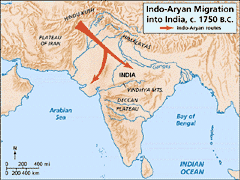
The relationship between the Dravidian languages and Prakritic languages is much more complicated than the ideas presented by Bh Krishnamurti. Krishnamurti argues that there were many Dravidians in India when the Indo-Aryans arrived; and that as a result Dravidian influenced the Indo-Aryan languages through the introduction of lexical items and (grammatical) structural features.
Due to early Dravidian settlement in Northern India there is a Dravidian substratum in Indo‑Aryan. There are Dravidian loans in the Rg Veda, even though Aryan recorders of this work were situated in the Punjab which occupied around this time by the BRW Dravidians.
There are islands of Dravidian speakers in Afghanistan, Iran and Pakistan. There are over 300,000 Brahui speakers in Qualat, Hairpur and Hyderabad districts of Pakistan. There are an additional 40,000 Brahui in Emeneau and Burrow (1962) found 500 Dravidian loan words in Sanskrit. In addition, Indo-Aryan illustrates a widespread structural borrowing from Dravidian in addition to 700 lexical loans (Kuiper 1967; Southward 1977; Winters 1989).
Iran and several thousand along the southern border of Russia and Yugoslavia. (ISDL 1983:227)
Emeneau and Burrow (1962) have found 500 Dravidian loan words in Sanskrit. the number of Dravidian loans in Indo‑Aryan is expected to reach 750.
There are numerous examples of Indo‑Aryan structural borrowings from Dravidian. For example, the Bengali and Oriya plural suffix ‑ra is analogous to the Tamil plural suffix ‑ar. Both of these suffixes are restricted to names of intelligent beings. (Chatterji 1970:173) Oriya borrowed the ‑gura plural suffix from the Dravidians. (Mahapatra 1983:67) Some researchers believe that the syntax of the Indo‑Aryan languages is ambivalent because of the Dravidian influence on these languages. As a result, they represent both SOV and SVO traits. If my theory is correct the relationship between Indo-Aryan and Dravidian languages is not the result of borrowing, it is due to the fact that the ancestors of the Vangi, Odri and Maharastri were descendents of the Kushite Anatolians.
In conclusion,the relationship between indo-Aryan and Dravidian languages are not the result, purely of contact with Dravidian speakers in India. These languages are related because the speakers of these languages formerly belonged to the C-Group or Kushite people of the region called Kusha Dwipa in the Sankritic text.
I believe that after the Hittites defeated the Hatti and Kaska and other peoples belonging to the Hurrian and Mitanni kingdoms, these people were uprooted and forced into Iran. The lost of Anatolia to the Hittites, probably forced these people to become nomads.
In Iran the Hatti, Kaska and Mitanni probably formed a significant portion of the Proto-Indo-Aryan population. Here they may have met Iranian speaking people,who may have practiced a hunter-gatherer existence, that adopted aspects of their Kushite culture , especially the religion and use of Mitanni religious terms and chariot culture. Joining forces with the Indo-Aryan (Mitannian-Hurrian-Kaska-Hatti) exiles they probably attacked Dravidian and Austronesian speaking people in India who lived in walled cities. The Austronesian and Dravidian people probably came in intimate contact during the Xia and Shang periods of China.
I have to reject the Afghanistan origin for the Indo-Aryan speaking people because the cultures there in ancient times show no affinity to Indo-European civilization. Given the Austronesian and Dravidian elements in Sanskrit and etc., I would have to date the expansion of the Indo-Aryan people sometime after 800 BC, across Iran, down into India.
This would explain why "the Vedic and Avestan mantras are not carbon copies of each other", they may have had a similar genesis, but they were nativised by different groups of Indic and Iranian speakers after the settlement of nomadic Hurrian, Kaska, Hatti and Mitanni people in Iran.
If this theory is correct the Kaska, Mittani and etc., were probably the ancestors of Prakrit speaking tribes of the Vangi, Odri and Maharastri.This view is supported by the relationship between Indo-Aryan and Mittani. H.H. Hock in Language History, Language Change, and Language Relationship , noted that Mittani “words contained in these passages are phonetically closer to the earliest attested Indo-Aryan than to Old Iranian” (p. 62).

No comments:
Post a Comment